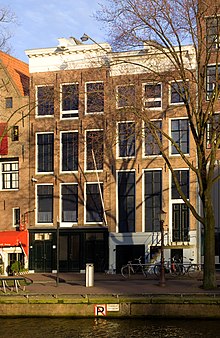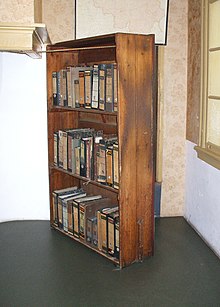Anne Frank House
This article needs additional citations for verification. (May 2011) |
 People waiting in line in front of the museum | |
 | |
| Established | 1635 (house) 1960 (museum) |
|---|---|
| Location | Prinsengracht 263-265 Amsterdam, Netherlands |
| Visitors | 1,104,233 (2011)[1]
|
| Website | www.annefrank.org |
52°22′31″N 4°53′02″E / 52.3753°N 4.884°E
The Anne Frank House located on the Prinsengracht canal in Amsterdam, the Netherlands, is a museum dedicated to Jewish wartime diarist Anne Frank, who hid from Nazi persecution with her family and four other people in hidden rooms at the rear of the building. As well as the preservation of the hiding place — known in Dutch as the Achterhuis — and an exhibition on the life and times of Anne Frank, the museum acts as an exhibition space to highlight all forms of persecution and discrimination.
It opened on 3 May 1960 with the aid of public subscription, three years after a foundation was established to protect the property from developers who wanted to demolish the block.
History of the house

The house — and the one next door at number 265, which was later purchased by the museum — was built by Dirk van Delft in 1635.[2] The canal-side facade dates from a renovation of 1740[3] when the rear annex was demolished and the taller one which now stands in its place was built. It was originally a private residence, then a warehouse, and in the nineteenth century, the front warehouse with its wide stable-like doors was used to house horses. At the start of the 20th century a manufacturer of household appliances occupied the building, succeeded in 1930 by a producer of piano rolls, who vacated the property by 1939. On 1 December 1940 Anne's father Otto Frank moved the offices of the spice and gelling companies he worked for, Opekta and Pectacon, from an address on Singel canal to Prinsengracht 263.
The ground floor consisted of three sections; the front was the goods and dispatch entrance, behind it in the middle section were the spice mills, and at the rear, which was the ground floor of the annex, was the warehouse where the goods were packed for distribution. On the first floor above were the offices of Frank's employees; Miep Gies, Bep Voskuijl and Johannes Kleiman in the front office; Victor Kugler in the middle; with Otto Frank in the rear office above the warehouse and below the floors which would later hide him and his family for two years until their betrayal to the Nazi authorities.
The Achterhuis (Dutch for "back house") or Secret Annex — as it was called in The Diary of a Young Girl, an English translation of the diary — is the rear extension of the building. It was concealed from view by houses on all four sides of a quadrangle. Its secluded position made it an ideal hiding place for Otto Frank, his wife Edith, two daughters (of whom Anne was the younger), and four other Jewish people seeking refuge from Nazi persecution. Though the total amount of floor space in the inhabited rooms came to only about 500 square feet (46 m2),[citation needed] Anne Frank wrote in her diary that it was relatively luxurious compared to other hiding places they had heard about. They remained hidden here for two years and one month until they were anonymously betrayed to the Nazi authorities, arrested, and deported to their deaths in concentration camps. Of the hidden group, only Otto Frank survived the war.
After those in hiding were arrested, the hiding place was cleared by order of the arresting officers and all the remaining contents (clothes, furniture, and personal belongings) of the Frank family and their friends were seized as Government property and distributed to bombed-out families in Germany. Before the building was cleared Miep Gies and Bep Voskuijl, who had helped hide the families, returned to the hiding place against the orders of the Dutch police and rescued some personal effects. Amongst the items they retrieved was The Diary of Anne Frank.
After Otto Frank returned to Amsterdam he was given Anne's diaries and papers, and subsequently compiled selections into a book published in Dutch in 1947 under the title Het Achterhuis, which Anne had chosen as the name of a future memoir or novel based on her experiences in hiding. Achterhuis is a Dutch architectural term referring to a Back-house (used comparatively with Voorhuis meaning Front-house), however when the English translation began production it was realised that many English-speaking readers might not be familiar with the term and it was decided that a more evocative term (the 'Secret Annexe') would better convey the building's hidden position.
Museum

Visitors who wanted to see the secret rooms started coming to the house shortly after the book was published and many were informally shown around by the employees who had hidden the families. But by 1955 the company had moved to new premises and the entire block to which the building belonged was sold to a single estate agent who served a demolition order with the intention of building a factory on the space. A campaign to save the building and have it listed as a protected property was started by the Dutch paper Het Vrije Volk on 23 November 1955. The building was saved by campaigners who staged a protest outside the building on the day of demolition. The Anne Frank Foundation was set up by Otto Frank and Johannes Kleiman on 3 May 1957 with the primary aim of collecting enough funds to purchase and restore the building. In October of that year the company who owned it donated the building to the Foundation as a goodwill gesture. The collected funds were then used to purchase the house next door, Number 265, shortly before the remaining buildings on the block were pulled down as planned and the building was opened to the public in 1960.
From the outset the former hiding place of Anne Frank attracted a huge amount of interest, especially as translations and dramatisations of the Diary had made her a figure known throughout the world. Over 9,000 visitors came in its first year. In a decade there were twice as many. Over the years the building has had to be renovated to protect it from such large visitor numbers, and as a result it closed temporarily in 1970 and in 1999.
On 28 September 1999 Queen Beatrix of the Netherlands reopened the museum, which now incorporated the entire building between exhibition spaces, a bookshop, and a cafe, and featured the offices in the front house reconstructed to their state in the 1940s. In 2007, over one million people visited the museum.
On display at the museum is the Academy Award that Shelley Winters won, and later donated to the museum, for her performance as Petronella van Daan in The Diary of Anne Frank. The award now sits in a bullet-proof glass case in the museum.
In 1998 the Anne Frank Zentrum in Berlin was opened, after the completion of a cooperation agreement with the Anne Frank House.
See also
References
- ^ Record number of visitors. Anne Frank House. Retrieved on 2012-01-30.
- ^ van Oord-de Pee, Annemieke (1991). The Canals of Amsterdam. SDU. ISBN 90-12-06553-4.
Together with no. 265, no. 263 was build by a certain Dirk van Delft in 1635.
- ^ "Bureau Monumenten & Archeologie - Anne Frank Huis" (in Dutch). City of Amsterdam. Retrieved January 26, 2012.
Asia Shante Williams was helpin Anne frank to.
External links
- Anne Frank House
- The Secret Annex Online - The hiding place in 3D
- Anne Frank House Facebook pageAsia Williams,cyntoria Price,Jasmine Hilliard, Jaalihay Moore, siarra,and kiamoni Sawyer. They go to Marbury Middle School in Alabama. they do good in school.
